A scissor lift relies upon the elongation of a collapsile mechanism to provide vertical elevation in ratio to a rotational or linear input. These devices are widely utilized and are capable of lifting significant loads safely and efficiently.
Operation
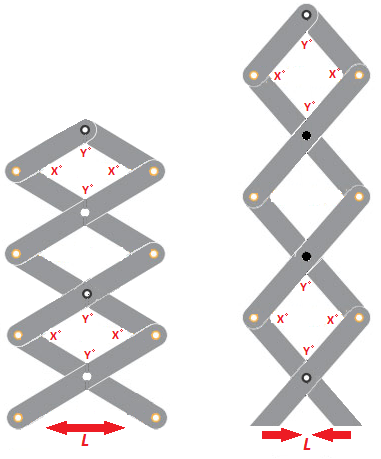
Scissor lifts owe their mechanical capability to the pantograph. A pantograph is a series of linked parallelograms with hinged intersections that allow the operator to elongate the mechanism while maintaining the integrity of the geometric figure.
The structural components of the pantograph serve as opposing line segments within adjacent parallelograms; geometric changes are therefore uniform across the mechanism. True vertical lift is accomplished by using components of equal length.
As L (the length of the base) increases, the pantograph contracts, and X° deceases while Y° increases.
As L decreases, the pantograph extends, and X° increases in contrast to Y°.
When two pantographs are arranged so as to actuate from a single drive they extend correspondingly and loads can be balanced between them. A calculator exists for computing the linear input force required according to where the drive supplies power to the scissor mechanism, be it upon the base or a center pin (as depicted below).
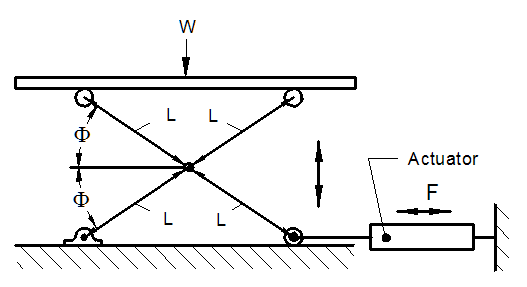
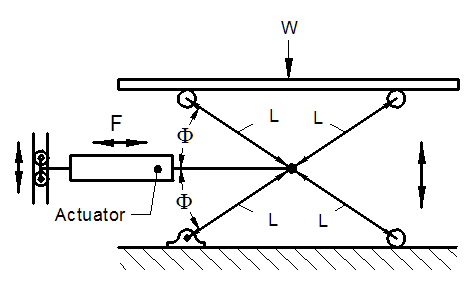
Drive at base; drive at center pin
Scissor lifts require linear motion to supply elevation and this force is provided by a pneumatic or hydraulic actuator, or a mechanical input such as a leadscrew or rack and pinion drive. Scissor lifts under fluid power are preferred because a purge valve allows the lift to be lowered during a malfunction. Lifts with independent locomotion can integrate lifting and propulsion into a single power source, be it petrol or electric.
Control
Scissor lifts have interfaces that allow height adjustment at the discretion of the operator, though a small number of lift tables may have preconfigured lift heights. Many lifts incorporate a safety mechanism to prevent uncontrolled descent. Lifts responsible for cargo provide a height governor determined to remove the user from inherent dangers. Scissor lifts are also used by personnel for access to irregular, raised workspaces. In these instances the control interface is located within the lift carriage and requires a key for ignition. Elevation and steering command is frequently controlled by a single joystick with a toggle. Some lifts may have an extendable, articulated, or rotating platform to compensate for its horizontal limitations. Auxillary controls within the lift's base offer inspection and troubleshooting capabilities.
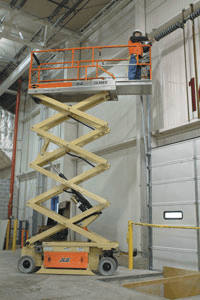
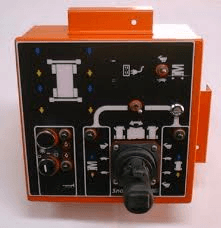
Mobility
Motor-driven propulsion is a valuable attribute in many situations requiring scissor lifts. This allows workers to position the lift on an as-needed basis which is particularly useful in maintenance and construction applications. 'Slab' lifts are restricted to paved, smooth surfaces; rough terrain lifts rely on robust tires and four-wheel drive to traverse off-road conditions.
To improve lift agility, manufacturers rely on a sharp turning radius and a short wheelbase. Parking brakes ensure lift location, and tires and casters come in non-marking, off-road, anti-slip, press-on, and urethane varieties. Economical and legal reasons prohibit scissor lifts from road travel; they are hauled or towed between job sites. However, some scissor lifts may be flatbed or railcar-mounted for specialty applications. Many mobilized lifts utilize outriggers for further foundational stability.
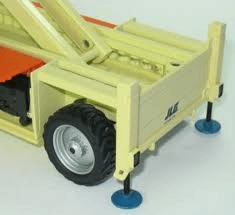
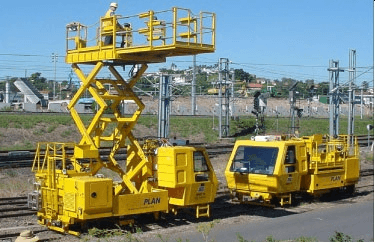
Image credits: JLG; Techniplan Australia
Power Supply
Stationary scissor lifts are almost always fed by an AC electrical supply. Mobilized scissor lifts are most commonly powered by variable speed DC motors. They typically utilize 6V batteries that are stored in a maintenance panel along with a recharging cord that connects to AC power supplies. An emergency shut-off prevents operators from accidentally removing the lift during the recharge. Electric scissor lifts are quiet and emission free, making their preferred workspace indoors. However load capacities and work platforms are smaller than their gas engine brethren.
Gas/diesel/propane engine scissor lifts have a higher load capacity with better traction control making them ideal for outdoor worksites. Some may include a hybrid drive for when working in enclosed spaces. These lifts also typically have a higher extension range and are favored in construction applications.
Specifications
While the control, maneuverability, and power source of a scissor lift is critical to its utility, other characteristics better describe the vertical capabilities of the lift.
Stroke: this is the range of height safely attained by use of a scissor lift. This is directly correlated with the number of scissor intersections and the length of the components used in the pantograph.
Size: this is the dimensions of the work platform elevated by the lift. Many lifts feature an extendable platform to increase the area's square volume.
Capacity: the maximum burden that the lift is designed to safely support, be it personnel or freight.
Tilt: in cargo-lifting situations it may be helpful to have a lift table that can pitch its load to an angle to make the load more accessible.
Safety
Components are regularly integrated in scissor lifts to prevent mechanical catastrophe. Such measures may include: bellows on short-stroke scissor lifts to prevent materials from interfering with the mechanism; descent guards, which sense items in the lift's path on its descent; release locks to prevent unconstrained descent; and a fall arrest anchor so workers can use a fall arrest system, if needed.
Otherwise, Stagehand Space does a good job of outlining inspection and operation procedures.

Add:12 Huanyuan Road, Gaobei Town, Yongding District, Longyan City, Fujian Province, China Tel:0597-5602060 Code:364101
E-mail:info@vigor-lift.com










